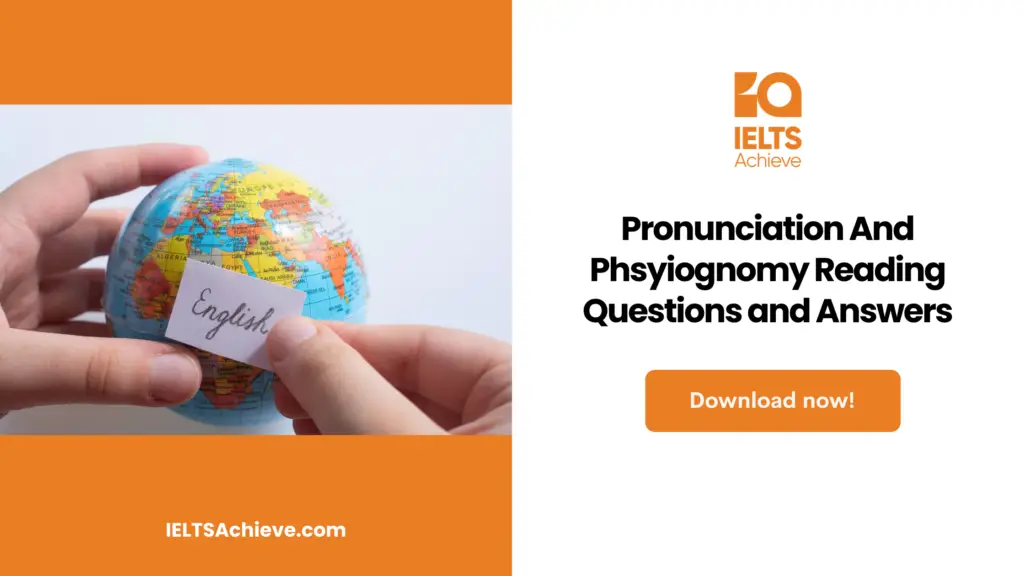The Blog post contains the following IELTS Reading Questions:
- IELTS Reading Matching Sentence Endings
- IELTS Reading Matching Features
- IELTS Reading Yes/No/Not Given
Stay informed and prepared for success – Explore our comprehensive Reading Test Info page to get valuable insights, exam format details, and expert tips for mastering the IELTS Reading section.
IELTS Reading Passage –Pronunciation And Phsyiognomy

Pronunciation And Phsyiognomy
Imagine the scene: you are sitting on the tube and on gets someone you instinctively feel is American. To make sure you ask them the time, and are right, but how did you know?
When we say someone ‘looks American’, we take into consideration dress, mannerism and physical appearance. However, since the Americans do not constitute one single race, what exactly is meant by ‘look’? In fact, one salient feature is a pronounced widening around the jaw – a well-documented phenomenon.
Writer Arthur Koestler once remarked that friends of his, whom he had met thirty years after they emigrated to the United States, had acquired an ‘American physiognomy’, i.e. a broadened jaw, an appearance which is also prevalent in the indigenous population. An anthropologist friend of his attributed this to the increased use of the jaw musculature in American enunciation. This ‘change of countenance’ in immigrants had already been observed by the historian M. Fishberg in 1910.
To paraphrase the philosopher Emerson, certain national, social and religious groups, such as ageing actors, long-term convicts and celibate priests, to give just a few examples, develop a distinguishing ‘look’, which is not easily defined, but readily recognised. Their way of life affects their facial expression and physical features, giving the mistaken impression that these traits are of hereditary or ‘racial’ origin. All the factors mentioned above contribute, as well as heredity. But the question of appearance being affected by pronunciation – as in the case of American immigrant including those from other English speaking countries over the course of many years – is of great interest, and calls for further study into the science of voice production. This can only benefit those working in the field of speech therapy, elocution and the pronunciation of foreign languages, and help the student from a purely physiological point of view. Naturally, the numerous psychological and socio-linguistic factors that inhibit most adult learners of foreign languages from acquiring ‘good’ pronunciation constitute a completely different and no less important issue that require separate investigation.
The pronunciation of the various forms of English around the world today is affected by the voice being ‘placed’ in different parts of the mouth. We use our speech organs in certain ways to produce specific sounds, and these muscles have to practise to learn new phonemes. Non-Americans should look in the mirror while repeating ‘I really never heard of poor reward for valour’ with full use of the USA retroflex /r/ phoneme, and note what happens to their jawbones after three or four repetitions. Imagine the effect of these movements on the jaw muscles after twenty years! This phoneme is one of the most noticeable features of US English and one that non-Americans always exaggerate when mimicking the accent. Likewise, standard British RP is often parodied, and its whine of superiority mocked to the point of turning the end of one’s nose up as much as possible. Not only does this enhance the ‘performance’, but also begs the question of whether this look is the origin of the expression ‘stuck up’?
Once on a Birmingham bus, a friend pointed to a fellow passenger and said, ‘That man’s Brummie accent is written all over his face.’ This was from someone who would not normally make crass generalisations. The interesting thing would be to establish whether thin lips and a tense, prominent chin are a result of the way Midlands English is spoken, or its cause, or a mixture of both. Similarly, in the case of Liverpool one could ask whether the distinctive ‘Scouse accent was a reason for, or the frequency of high cheekbones in the local population.
When one learns another accent, as in the theatre for example, voice coaches often resort to images to help their students acquire the distinctive sound of the target pronunciation. With ‘Scouse’, the mental aid employed is pushing your cheekbones up in a smile as high as they will go and you have got a very slack mouth full of cotton wool. The sound seems to spring off the sides of your face—outwards and upwards. For a Belfast accent, one has to tighten the sides of the jaws until there is maximum tension, and speak opening the lips as little as possible. This gives rise to the well-known ‘Ulster jaw’ phenomenon. Learning Australian involves imagining the ordeals of the first westerners transported to the other side of the world. When exposed to the merciless glare and unremitting heat of the southern sun, we instinctively screw up our eyes and grimace for protection.
Has this contributed to an Australian ‘look’, and affected the way ‘Aussies’ speak English, or vice versa? It is a curious chicken and egg conundrum, but perhaps the answer is ultimately irrelevant. Of course other factors affect the way people look and sound, and it would certainly be inaccurate to suggest that all those who speak one form of a language or dialect have a set physiognomy because of their pronunciation patterns. But a large enough number do, and that alone is worth investigating. What is important, however, is establishing pronunciation as one of the factors that determine physiognomy, and gaining a deeper insight into the origins and nature of the sounds of speech. And of course, one wonders what ‘look’ one’s own group has!
Unlock your full potential in the IELTS Reading section – Visit our IELTS Reading Practice Question Answer page now!
Recommended Questions:
Renewable Energy IELTS Reading Question with Answer
Questions 28-30
Look at the following people (Questions 28-30) and the list of statements below.
Match each person with the correct statement.
28 Koestler
29 Fishberg
30 Emerson
A Americans use their jaw more to enunciate
B immigrants acquire physiognomical features common among the indigenous population
C facial expression and physical features are hereditary
D lifestyle affects physiognomy
E Americans have a broadened jaw
F His friend’s appearance had changed since they moved to the United States.
G the change of countenance was unremarkable
Improve your performance in Matching Features questions by clicking here to access our comprehensive guide. Learn how to match specific features or characteristics with the options provided in the IELTS Reading section.
Questions 31-36
Do the following statements reflect the claims of the writer in Reading Passage 3?
In boxes 31-36 on your answer sheet write
YES if the statement agrees with the information in the passage
NO if the statement contradicts the information in the passage
NOT GIVEN if there is no information about the statement in the passage
31 Further study into the science of voice production will cost considerable sums of money.
32 The psychological and socio-linguistic factors that make it difficult for adult learners of foreign languages to gain ‘good’ pronunciation are not as important as other factors.
33 Speech organs are muscles.
34 New phonemes are difficult to learn.
35 People often make fun of standard British RP.
36 Facial features contribute to the incomprehensibility of Midlands English.
Want to excel in identifying the writer’s views and claims? Click here to explore our in-depth guide on how to accurately determine Yes, No, or Not Given in the IELTS Reading section.
Questions 37-40
Complete each of the following statements (Questions 37-40) with the best ending A-I from the box below. Write the appropriate letters A-I in boxes 37-40 on your answer sheet.
37 Voice coaches
38 The Scouse accent
39 Whether the way we look affects the way we speak or the other way round
40 It is important to prove that pronunciation
A can be achieved by using mental aid
B is irrelevant
C is worth investing
D use images to assist students with the desired pronunciation
E is a chicken and egg conundrum
F get the target
G can affect appearance
H is not as easy as a Belfast one
I makes you smile
Ready to sharpen your skills in Matching Sentence Endings? Click here to discover expert strategies and techniques for accurately matching sentence endings with the corresponding information in the IELTS Reading section.
Unlock your full potential in the IELTS Reading section – Visit our IELTS Reading Practice Question Answer page now!
Recommended Questions:
Renewable Energy IELTS Reading Question with Answer

We hope you found this post useful in helping you to study for the IELTS Test. If you have any questions please let us know in the comments below or on the Facebook page.
The best way to keep up to date with posts like this is to like us on Facebook, then follow us on Instagram and Pinterest. If you need help preparing for the IELTS Test, join the IELTS Achieve Academy and see how we can assist you to achieve your desired band score. We offer an essay correction service, mock exams and online courses.


